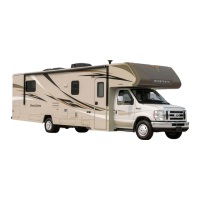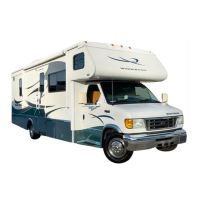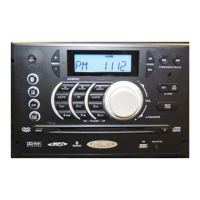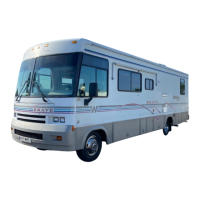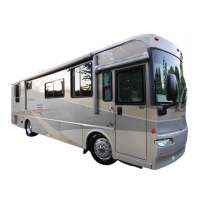Do you have a question about the Winnebago Minnie Winnie and is the answer not in the manual?
Information on appliances and equipment from manufacturers.
Describes model variations and components that may not apply to your coach.
Essential checks and awareness before operating the motor home.
Information on dealer support and warranty service.
Details the factory warranty against defects in material and workmanship.
Emphasizes responsible alcohol consumption and driving.
Instructions for reporting vehicle defects to NHTSA and Winnebago.
Contains vehicle identification and important reference information.
Visual guide to external features of Class C motor homes.
Essential safety practices for vehicle occupants while moving.
Precautions and advice for safe operation of the motor home.
Safe handling and precautions related to fuel and LP gas systems.
Procedures for identifying and responding to LP gas leaks.
Information on the function and use of the LP gas detector.
Important safety measures for working with electrical components and systems.
Guidelines for safely storing and securing items inside the motor home.
Safety advice related to vehicle maintenance procedures.
Information on formaldehyde emissions and potential health effects.
Warnings and precautions regarding carbon monoxide hazards.
Information on locating and using emergency exit windows.
Location, inspection, and usage guidelines for the fire extinguisher.
Details on the smoke alarm's function, testing, and maintenance.
Recommended procedures for a safe pre-entry vehicle inspection.
Essential checks and adjustments before starting to drive.
Information about the types of keys and their importance.
Guidance on selecting the correct fuel and safe filling procedures.
Instructions for operating the engine, including interlock and shut-off switches.
Proper use of parking brake and hazard warning lights.
Operation and security of vehicle doors and locks.
Instructions for extending and retracting the entrance step.
Adjustment and swiveling features for driver, co-pilot, and lounge seats.
How to adjust the driver and co-pilot seat armrests.
Proper use, fastening, and care of lap and lap-shoulder belts.
Requirements and guidance for installing and using child restraint systems.
Adjusting mirrors for optimal rear visibility.
Overview of instrument panel features and controls.
Identification of gauges and controls on the Ford chassis instrument panel.
Procedures for wheel nut torque and safe vehicle recovery towing.
Safety precautions and steps for jump starting the vehicle.
Causes, symptoms, and steps to take for an overheating engine.
Distributing cargo to avoid exceeding weight ratings.
Importance of checking and adjusting front suspension alignment.
How to determine the loaded weight of your coach.
Guidelines on seating capacity, cargo limits, and roof load restrictions.
Capacities, safety, and equipment recommendations for trailer towing.
A comprehensive list of checks before starting a trip.
Items to pack and considerations for trip preparation.
List of essential safety and emergency equipment to carry.
A brief list for loading essentials for cooking, cleaning, and bathroom needs.
General advice and tips for traveling in your motor home.
Precautions and advice for dealing with severe weather conditions.
Special considerations for driving safely during nighttime hours.
Techniques for driving safely in mountainous terrain.
Tips for parking and leveling the motor home at a campsite.
Methods for leveling the motor home using blocks and chocks.
Managing moisture inside the coach to prevent damage.
Overview of the LP gas system and essential safety practices.
Explanation of the basic principles of LP gas operation.
Factors to consider when choosing between propane and butane.
Information on LP gas output and the vehicle's tank system.
Procedures for refilling the LP tank and addressing air in the system.
Regulations concerning transporting LP gas tanks.
Information about the LP gas pressure regulator and its maintenance.
Tips for efficient LP gas usage in cold weather conditions.
Procedures for identifying and responding to LP gas leaks.
Operation and components of the 110-volt AC electrical system.
Connecting and using the external power cord.
Function and operation of the power converter system.
How the converter charges coach batteries.
Protection mechanism for the power converter section.
Purpose and operation of 110-volt circuit breakers.
Location and use of standard AC electrical outlets.
Safety feature protecting against electrical shock.
Operation and safety for the optional 110-volt generator.
Procedures for starting and stopping the generator engine.
Function of the hourmeter for tracking generator usage.
Critical safety warnings and cautions for generator operation.
Overview of the automotive and coach battery systems.
Protection for 12-volt circuits in the coach area.
Best practices for storing and maintaining lead-acid batteries.
How to check the charge level of the coach battery.
Information on connecting trailer or tow vehicle wiring.
Components and operation of the fresh water supply.
Procedures for filling the fresh water tank.
Operation of the water pump and its control switch.
Recommended steps for disinfecting the potable water system.
Connecting to and using external water sources.
Explanation of normal shower valve operation and potential dripping.
Use and location of the exterior auxiliary shower.
Overview of the self-contained waste drainage and holding tank system.
Step-by-step guide for properly dumping waste holding tanks.
Guidelines for connecting to external sewer hook-ups.
How to check holding tank levels using the monitor panel.
Location and operation of valves for draining water lines and tanks.
Using the valve for winterizing the fresh water system.
Capacities for black and gray water holding tanks by model.
Detailed locations of drain valves for various models.
Instructions for operating the Norcold refrigerator, including modes and leveling.
Importance of leveling the unit for proper refrigerator cooling.
Step-by-step guide for starting the refrigerator in manual and auto modes.
Operation of the humidity control and storage switch.
Advice for optimal refrigerator performance and food storage.
Instructions for using the gas range and oven, including top burners.
How to operate the oven control and light the pilot.
Reference to manufacturer's information for microwave oven operation.
Function of the range hood fan and light, and location of monitor panel.
Controls for operating the range hood fan and light.
Operation of the water heater switch and troubleshooting the pilot light.
Monitoring tank levels and operating the water pump.
Using the meter to check coach battery charge.
Detailed instructions for operating the direct ignition water heater.
Understanding and replacing the air gap in the relief valve.
Using the by-pass valve for winterization and normal flow.
How the motor aid system heats water using the engine.
Startup and operation instructions for the Suburban LP gas furnace.
Reference to manufacturer's instructions for roof AC operation.
Raising, rotating, and lowering the TV antenna.
General advice on chassis service, engine, tires, and alignment.
Importance of proper tire inflation, alignment, and balance.
Checks for wipers, lights, and automotive electrical protection.
Information regarding proper awning installation and dealer services.
Steps to take to protect the vehicle during storage.
Detailed procedure for winterizing the plumbing system.
Steps to take to prepare the motor home after storage.
| Fuel Type | Gasoline |
|---|---|
| Transmission | 6-speed automatic |
| Fuel Capacity | 55 gallons |
| Chassis | Ford E350/E450 |
| Engine | 7.3L V8 |
| Fresh Water Capacity | 40 gallons |
| GVWR | 12, 500 to 14, 500 lbs |
| Exterior Height | 11 ft 1 in |
| Exterior Width | 8 ft 6 in |

